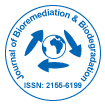Research Article
Genetic Basis of Naphthalene and Phenanthrene Degradation by Phyllosphere Bacterial Strains Alcaligenes faecalis and Alcaligenes sp. 11SO
| Undugoda LJS, Kannangara S* and Sirisena DM | |
| Department of Botany, Faculty of science, University of Kelaniya, Kelaniya, Sri Lanka | |
| *Corresponding Author : | Kannangara S Department of Botany, Faculty of science University of Kelaniya, Kelaniya, Sri Lanka E-mail: sagarikadpk@kln.ac.lk |
| Received January 11, 2016; Accepted February 10, 2016; Published February 15, 2016 | |
| Citation: Undugoda LJS, Kannangara S, Sirisena DM (2016) Genetic Basis of Naphthalene and Phenanthrene Degradation by Phyllosphere Bacterial Strains Alcaligenes faecalis and Alcaligenes sp. 11SO. J Bioremed Biodeg 7:333. doi:10.4172/2155-6199.1000333 | |
| Copyright: © 2016 Undugoda LJS, et al. This is an open-a ccess article distributed under the terms of the Creative Commons Attribution License, which permits unrestricted use, distribution, and reproduction in any medium, provided the original author and source are credited. | |
Abstract
Two bacterial strains, Alcaligenes feacalis and Alcaligenes sp. 11SO isolated from the phyllosphere of four ornamental plant species, Ixora chinensis, Ervatamia divaricata, Hibiscus rosa-sinensis and Amaranthus cruentus found in five highly polluted sites in Sri Lanka, showed a higher level of phenanthrene and naphthalene degradation ability. Both these strains harbor plasmids conferring them resistance to ampicillin. Curing of these strains of their plasmid drastically reduced the ability to degrade the hydrocarbons. Upon transformation of these plasmids into E.coli JM109 enable it to degrade the two hydrocarbons efficiently. Plasmid encoded phenanthrene and naphthalene degradation suggested the presence of required catabolic genes in these plasmids. PCR amplification with degenerate primers and comparison of their nucleotide sequences with Genbank sequences indicated that plasmids of those bacterial strains harbor the genes nahR, nahU involved in naphthalene degradation and phnG for phenanthrene degradation. RFLP and nucleotide sequence comparison of nahU and nahR amplicons revealed that both of these genes in two bacterial strains are homologous. But, phnG gene copies of two bacterial strains exist as two distinct alleles.
